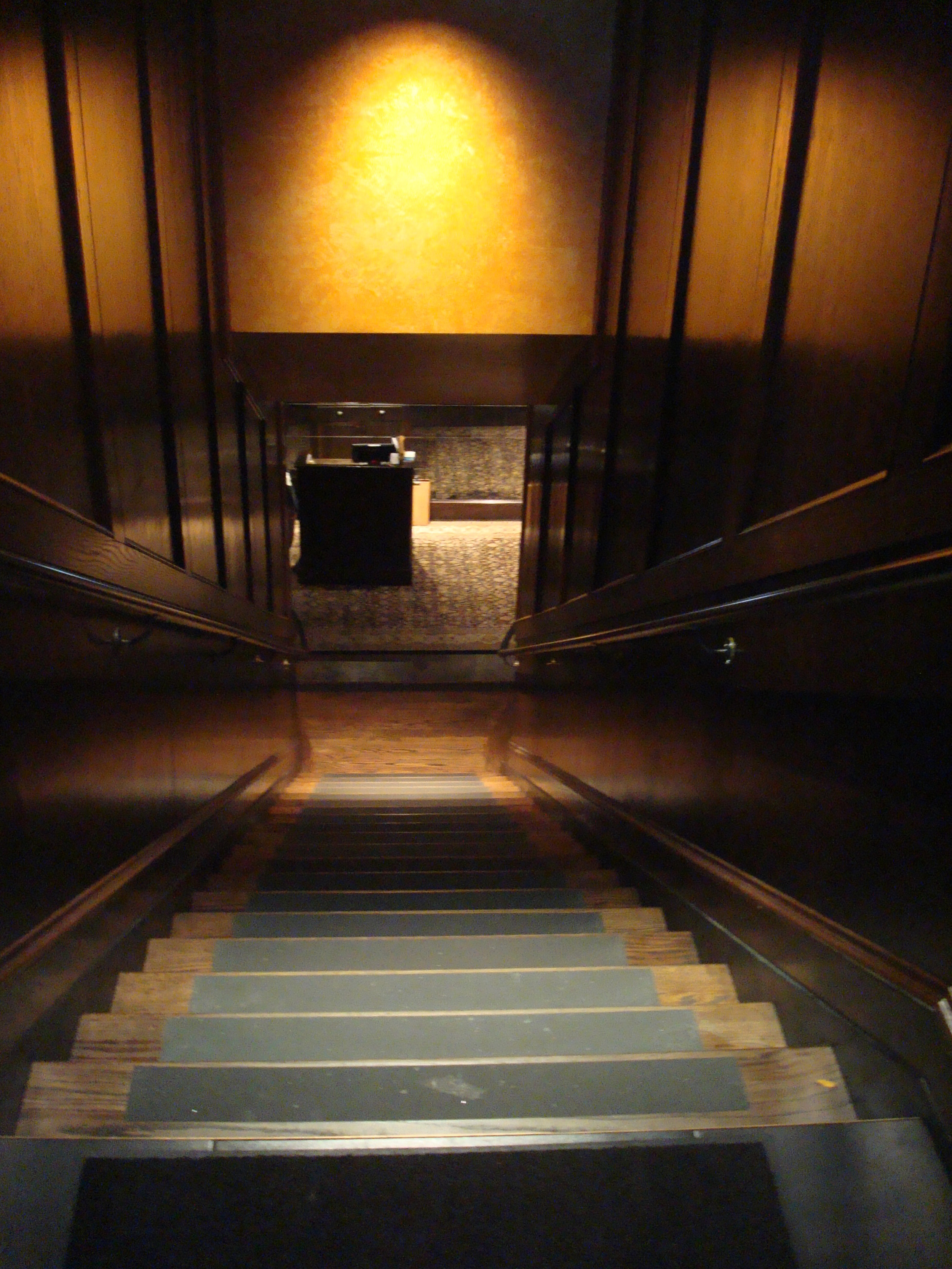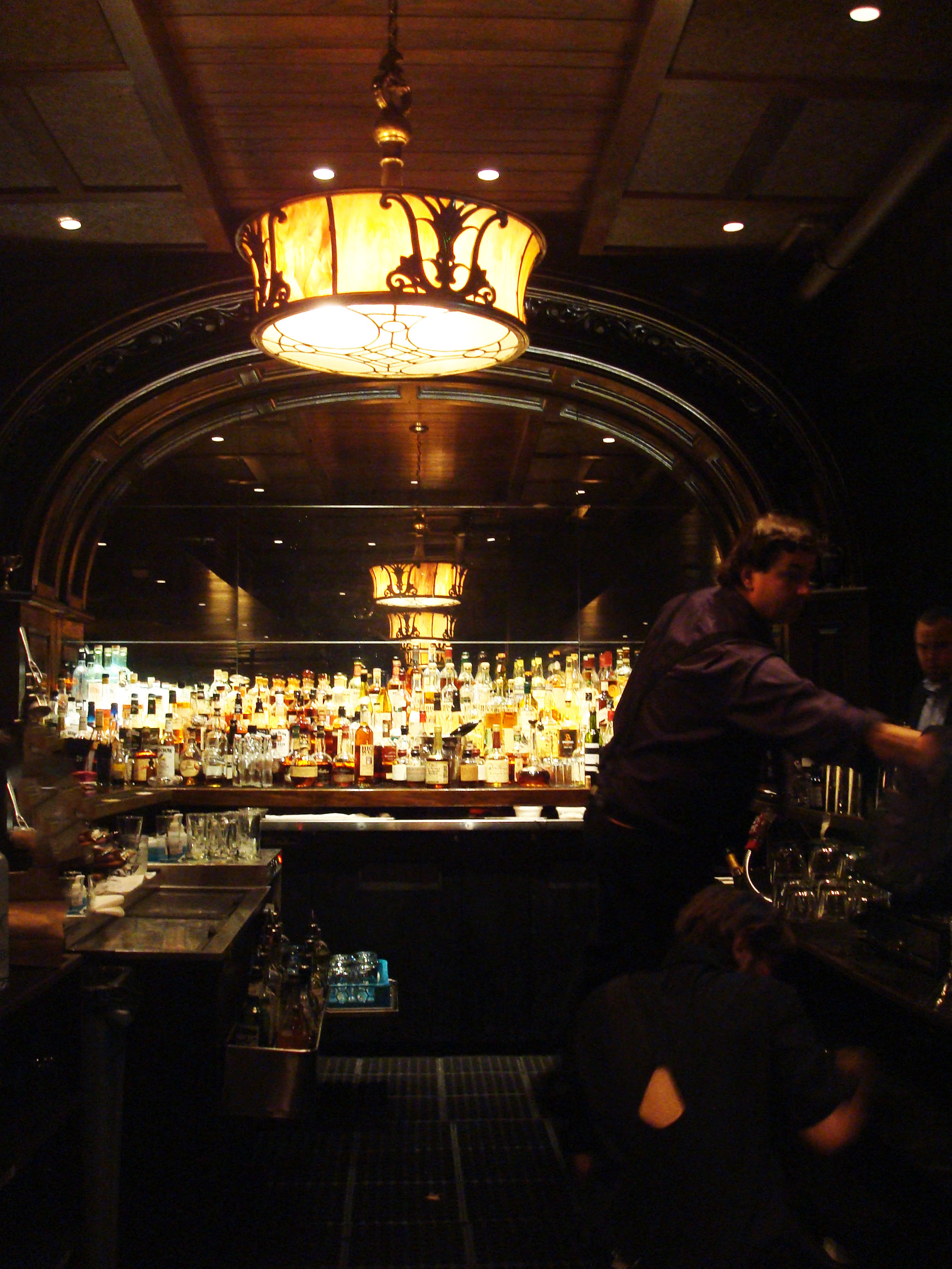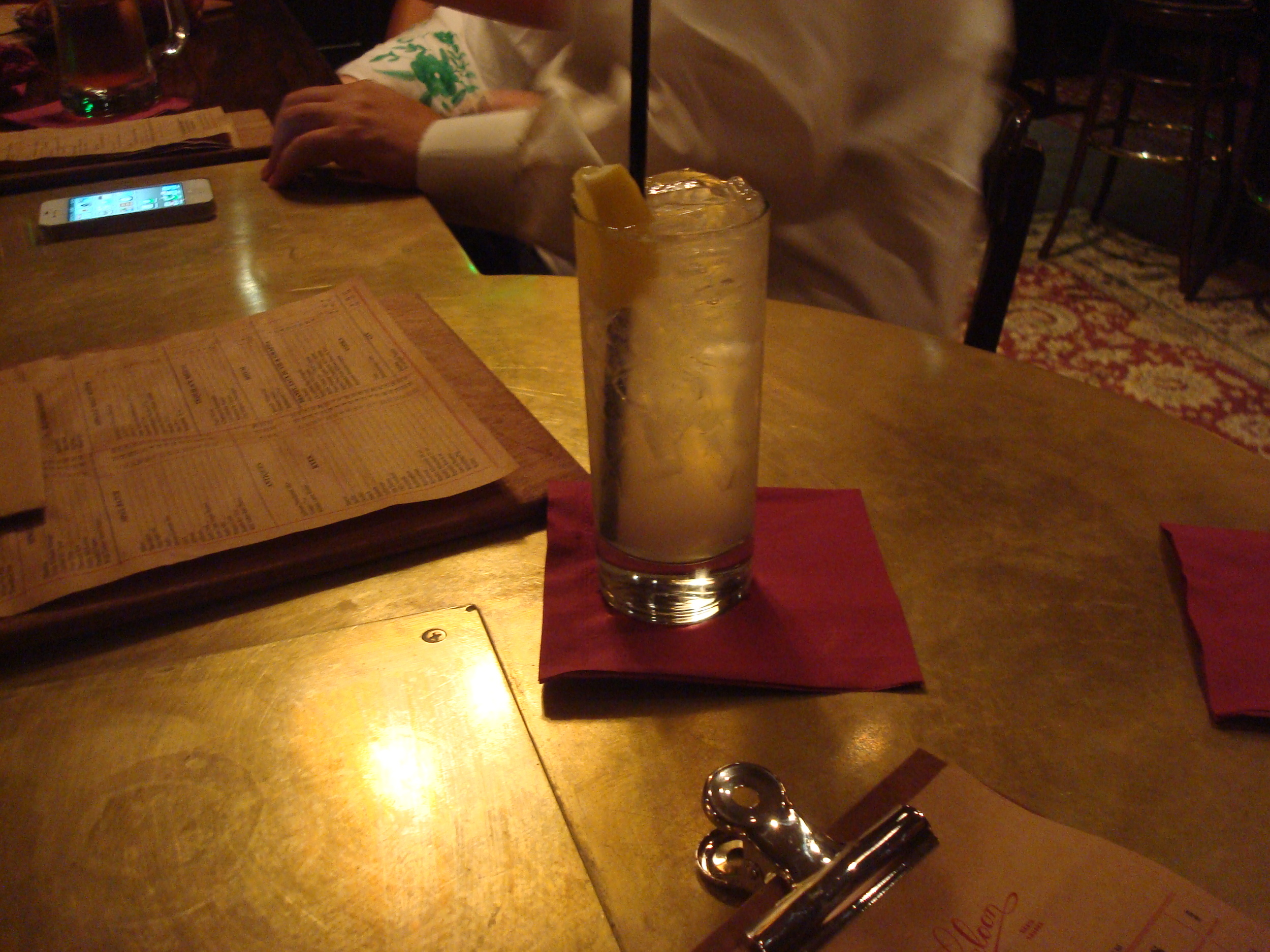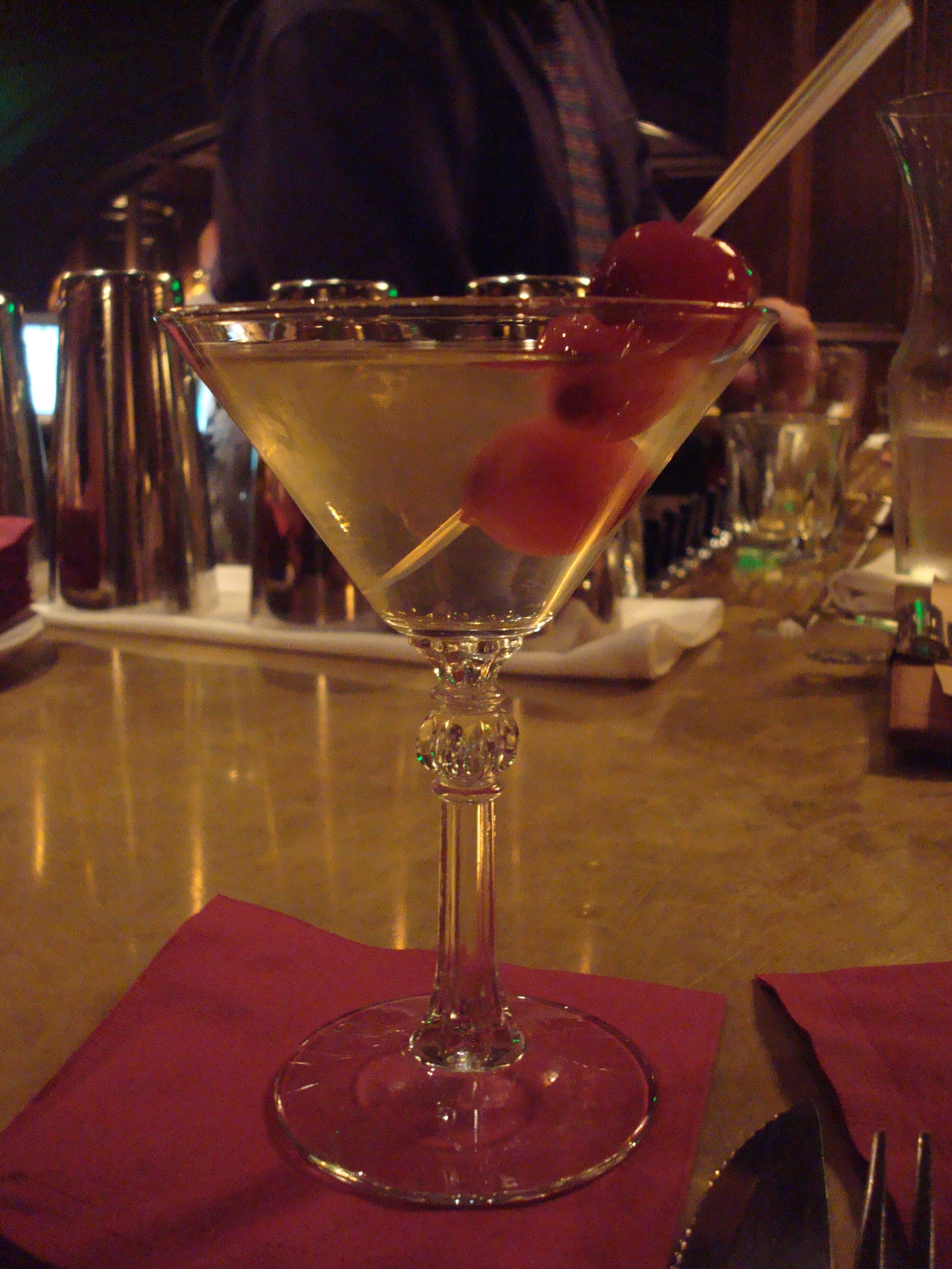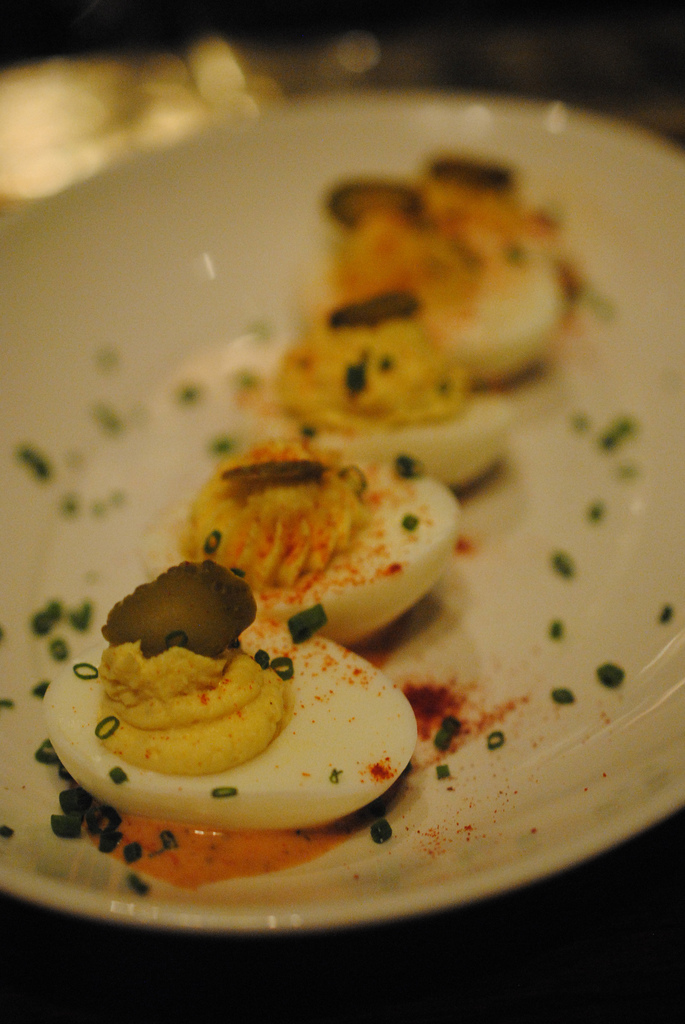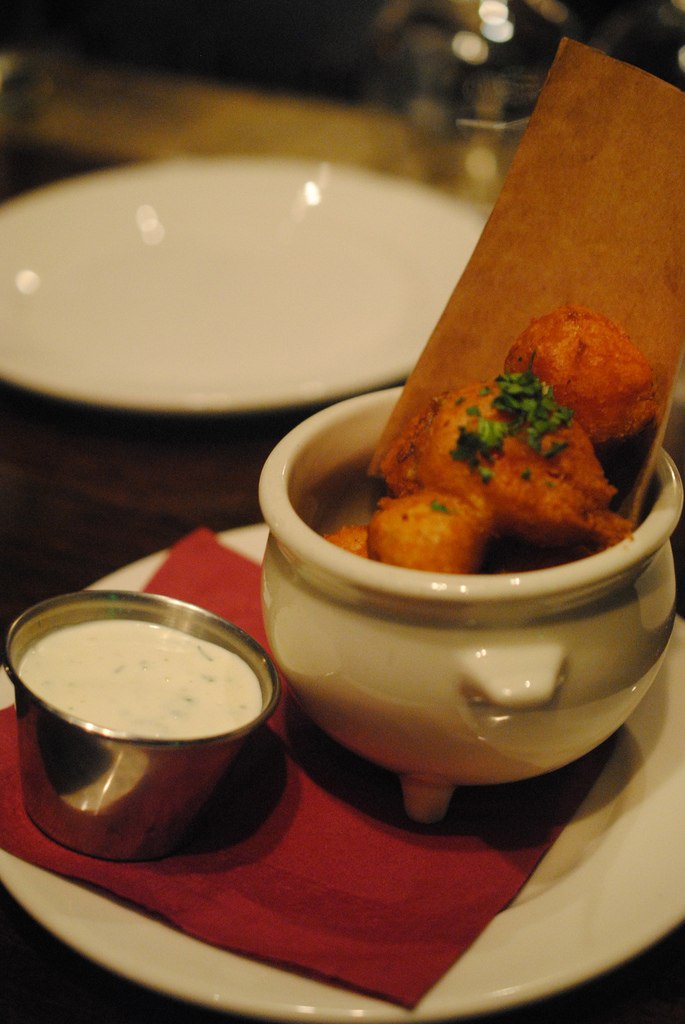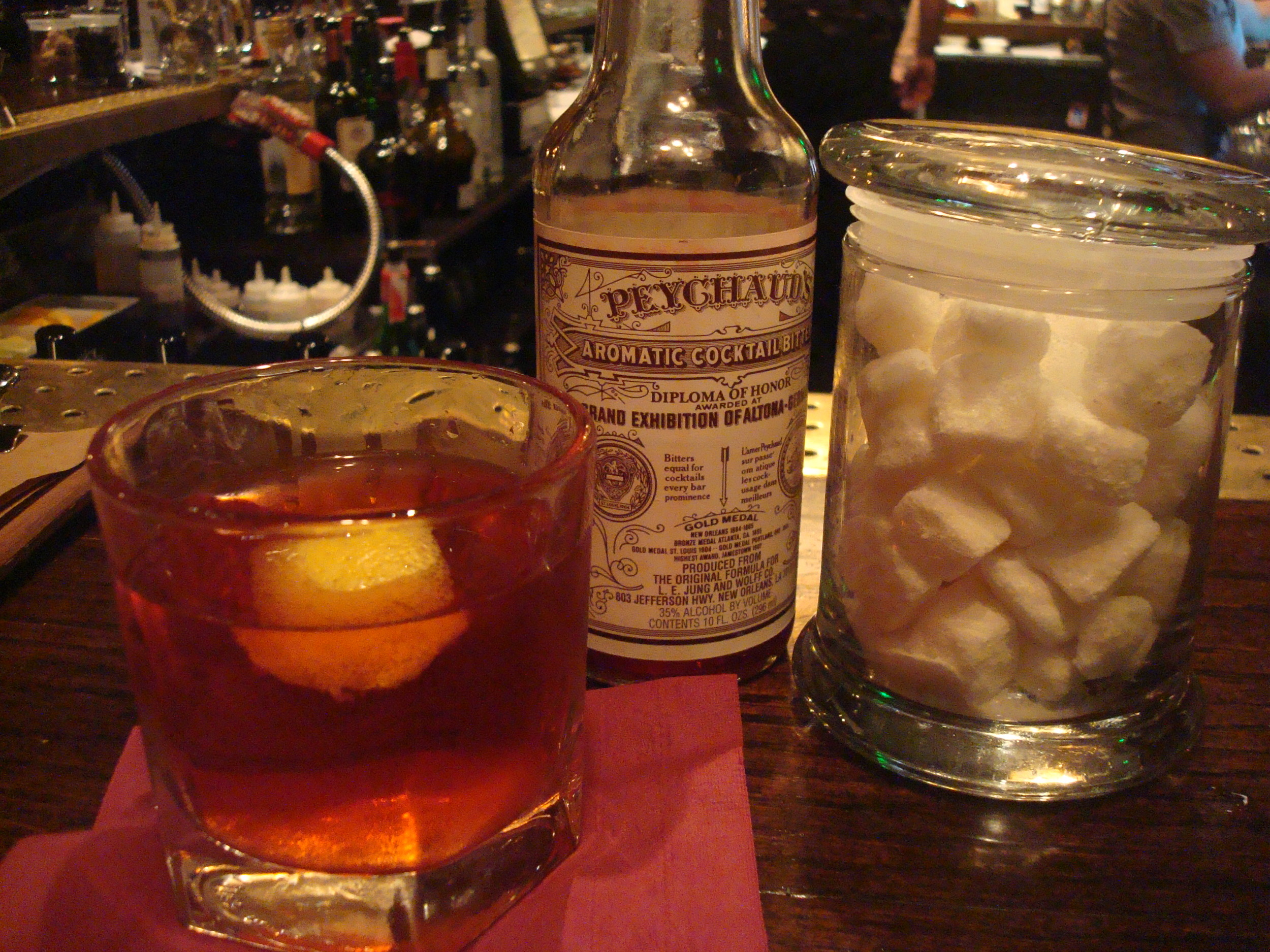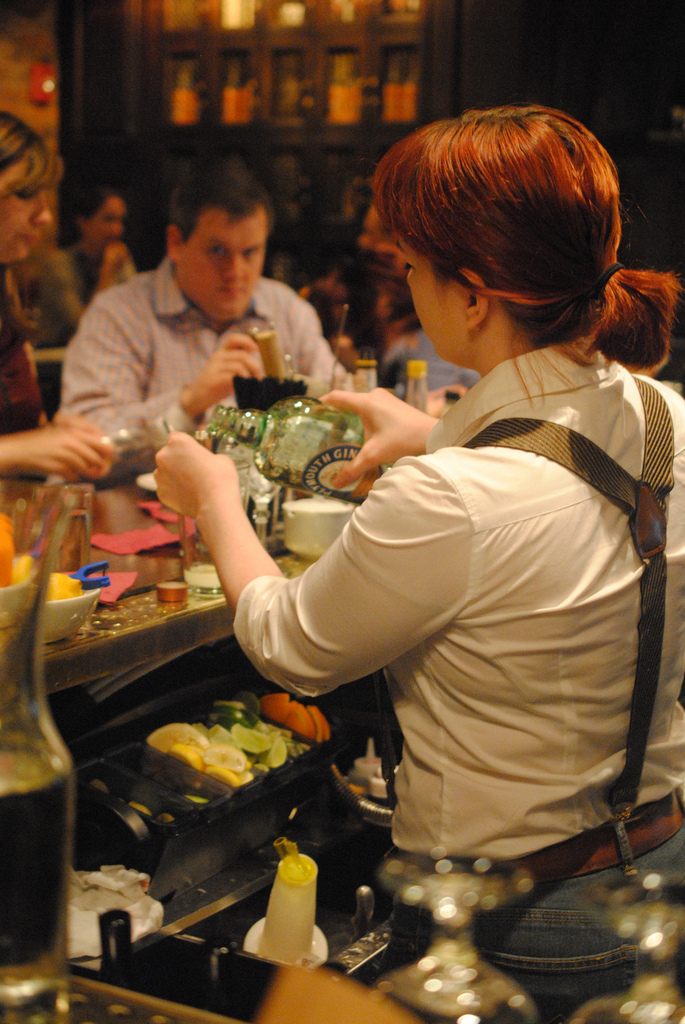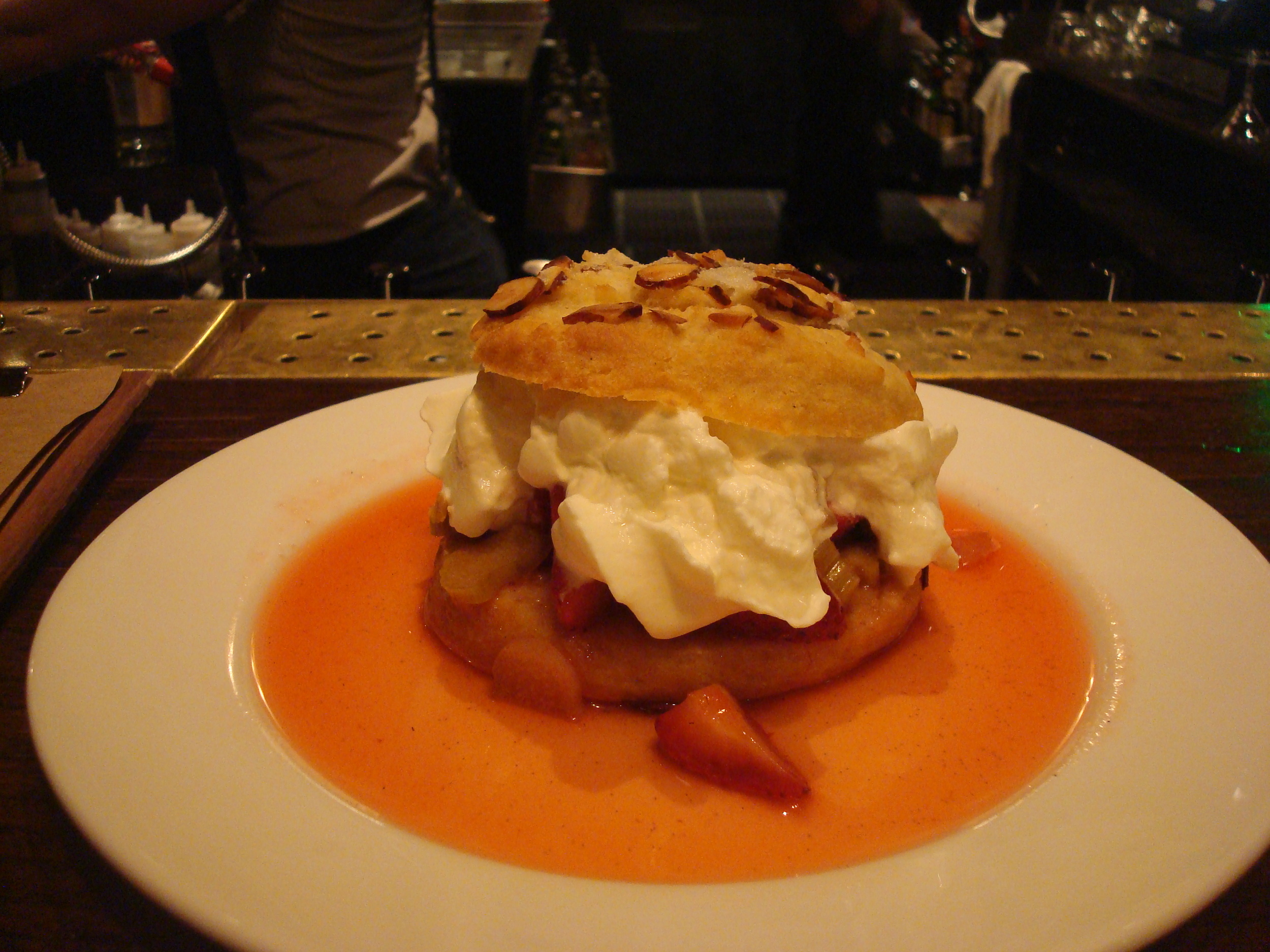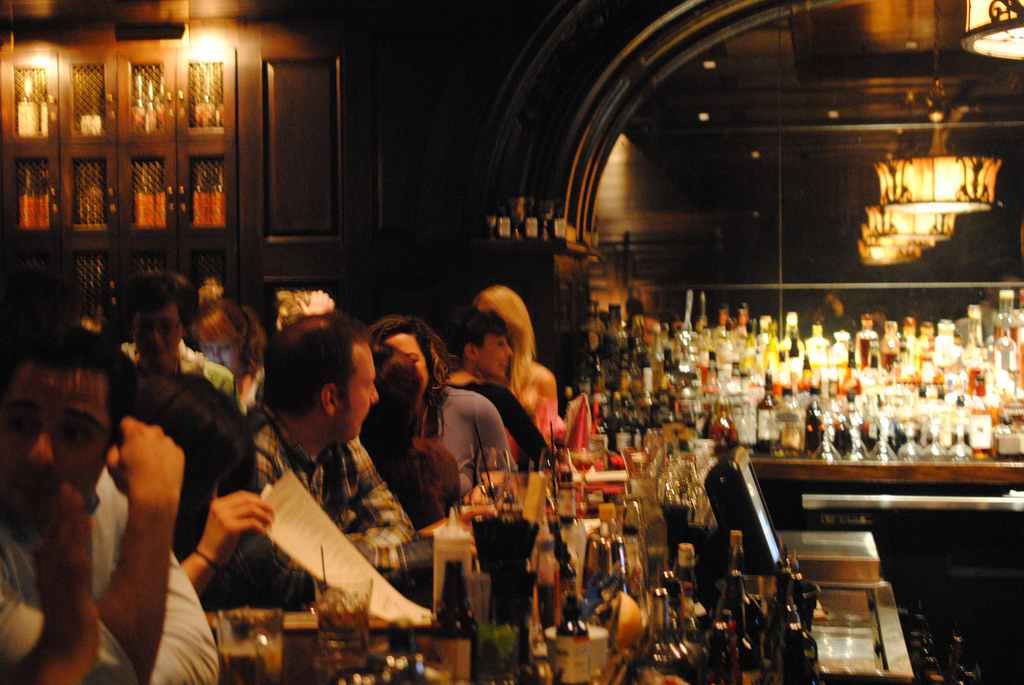At this point it’s an understatement to say that Boston’s become a craft cocktail kind of town. I’ve already talked about Scholars, Church, Marliave, Emerald, Russell House Tavern, and a few other places that make wonderfully innovative drinks.
Then there are heavy hitters like Drink, Brick & Mortar, Eastern Standard, and many others that I either haven’t been to yet or haven’t had a chance to write about. And I can’t even begin to count the bars, well-renowned or not, that proudly display impressive menus devoted to superior concoctions or have highly skilled bartenders who can craft you a customized drink on the spot.
It seems fitting, then, that at a time when cocktails have experienced such a resurgence in the Boston area, we have a place like Davis Square’s Saloon – lovingly devoted to an era when cocktails were something special and required a particular skill to create.
Saloon is a well-conceived and beautifully executed tribute to pre-Prohibition American drinking establishments. From the cocktails, to the décor, to the food, to the snazzy outfits worn by the bartenders, walking into Saloon is like slipping into an early 20th century period piece – a time when, as Saloon’s website says, drinks were “serious and uncomplicated.”
Saloon captures one of the golden ages of cocktail making. Drinks may have been fairly simple back then, from the perspective of having fairly basic ingredients, but there was still a level of artistry involved in their composition.
That nuanced approach was greatly diminished with the onset of Prohibition. When the foolish Volstead Act outlawed the purchase and sale of intoxicating liquors, those who plied their trade on making drinks left for places like Paris and London, where their skills were still appreciated and, more importantly, legal. Or they stayed in America and were reduced to working illegally in shabby, makeshift “bars,” with far inferior ingredients.
Saloon hearkens back to those pre-Prohibition days, serving the sort of drinks that went out of style but shouldn’t have. True to the era they aim to emulate, Saloon’s signature cocktails are built on the basics – whiskey and gin. They’re not advertising chocolate martinis or colorful cosmopolitans, though I imagine they’ll make you whatever you want.
It is doubtless for all these reasons that, on a near-weekly basis since I started this blog, people have asked me “Have you been to Saloon yet?”
Yes, I’ve been; and there’s plenty to say. So toss a few ice cubes in a glass, pour yourself a generous serving of bourbon, and join me for a trip to a time when drinking was an art form, jazz was still young, and a night out was a formal affair.
Even though Saloon pays tribute to the days before Prohibition, it possesses elements of the speakeasies that started popping up when serving alcohol became a crime.
For starters, just finding Saloon can be a bit of a challenge. The first time I went, I walked right past it, even though I knew exactly where it was supposed to be. My sister Kelly, with whom I went most recently, had a similar experience, as have others. Saloon’s presence is indicated only by a small, illuminated globe bearing its name, and its nondescript, unmarked door tends to blend in with its surroundings.
Once you’ve located the door, you descend a long flight of stairs into a dark, subterranean bar with no windows, almost giving it an air of the secrecy that marked illegal drinking establishments back in the 1920s.
But any similarity to a sawdust-on-the-floor speakeasy falls away with one look at the subdued opulence of Saloon.
Kelly said it made her think of a library in a mansion; her imagination is expensive but accurate. Saloon’s interior has a very distinguished, elegant, old-money appearance. Exposed brick walls with cherry wood accents, dark-paneled wood on the ceiling, and worn-looking stone floors covered with Oriental rugs contribute to an atmosphere of reserve and maturity.
Dark red leather seating in the booths and well-stocked liquor cabinets on the walls paint a portrait of turn-of-the-century high society.
Chandeliers, wall sconces, and floor lamps make the good-size room feel cozy and intimate. The luxurious bar seats about 20 people, and there are maybe 30 tables or so for dining. Fresh ingredients adorn the bar, so you know you’re getting a quality cocktail.
Stepping into Saloon makes me feel like I’ve been invited into the den of some titan of industry for a snifter of brandy while we negotiate some back-room deal that will net us both millions. If only...
The owners of Saloon left few stones unturned in their efforts to evoke a classic American early 20th century mood. Big-band jazz plays at a comfortable level that doesn’t inhibit conversation. At times, it almost sounded like a band was tuning up in the next room; whether that’s because of the acoustics, or whether I was just swept up by the atmosphere, I’m not entirely sure.
The bar staff is decked out in spiffy duds with suspenders, providing an air of formality. The menus are printed on crinkly paper and affixed to clipboards (I don’t know what menus looked like a century ago, but since I’m guessing they weren’t all glossy and laminated, this is probably a faithful re-creation).
And there are no TVs. When’s the last time you were in a bar that had no TV?
That’s all well and good, but this is a bar, not a museum. So with that, we turn to the cocktails, the real star of this historical fantasy.
A cocktail was originally defined by just a few ingredients – spirits, bitters, water, sugar. Saloon’s drinks aren’t so severe, but they also don’t stray far from that formula. Their cocktail menu is divided into three sections – Bespoke (“mixed expressly for this establishment”), Strained, and Cubed. Whiskey and gin dominate, as they did back in the day, but Saloon offers a stunning array of spirits if you don’t feel like fully immersing yourself in tradition.
On my first visit I started right at the top of the drink list, ordering an Americana – bourbon, brown sugar, J. Thomas bitters (don’t ask, I have no idea), and sparkling wine. The sweetness of the sugar tamed the bite of the bourbon, and the sparkling wine gave the drink a pleasant, lively effervescence. A fine start to the evening, and a worthy introduction to Saloon.
Of course I had to try my favorite cocktail – a Manhattan. I figured that this most traditional of drinks would be handled deftly by a place so steeped in tradition, and I wasn’t disappointed. Bourbon, sweet vermouth, a dash of bitters, and a maraschino cherry. No more, no less.
Yet Saloon managed to surprise me. As I sipped it, I thought…what the hell kind of bourbon is this? So I asked the bartender “What the hell kind of bourbon is this?” He told me it was made, much to my surprise, with Old Granddad – the source of a long-running joke between my brother and me, and as bourbons go, not what you’d call top-shelf.
But then again, it’s exactly the sort of brand they’d have used back in the day, before there were so many domestic and imported options at our disposal. The drink was excellent, and once again, I was impressed with Saloon’s attention to detail.
On my second visit to Saloon, Kelly and I arrived around 5:30 to find about 15 patrons, mostly at the bar. I began my night with a Hamilton Daiquiri, a refreshing mix of rum, maraschino liqueur, lime, mint simple syrup, and tiki bitters.
With plenty of ice and garnished with a mint leaf, it was a delightful summertime drink.
Kelly opted for the descriptively titled “Vodka Drink” – vodka, sage simple syrup, limoncello, and soda. Clearly her favorite selection of the night, Kelly said the Vodka Drink was like gulping sipping a lemonade and couldn’t get over how simple it was (I guess the name was well chosen). Both that and the Hamilton Daiquiri provided much-needed relief after coming in from the broiling July heat.
Kelly’s next move was the Repo Man. I’m glad she got that one, because any drink that combines tequila and grappa isn’t high on my must-try list. She said it was intense (no kidding) but refreshing in its own way – I suppose the yellow chartreuse, St. Germain, lemon, and grapefruit bitters kept things in line. “This one has to go down more slowly,” she wisely added.
Since Kelly took a risk with the Repo Man, I couldn’t allow myself to be outdone. That said, a Gibson (a martini with a cocktail onion in place of an olive) might not sound terribly adventurous, but since I rarely order martinis on account of my dislike for dry vermouth, it at least qualifies as moderately bold. I was intrigued by Saloon’s “Another Gibson,” served with house-brined cocktail onions.
As I debated its merits, Kelly pointed out that it was also made with chive-infused gin…the novelty of which, I quickly decided, easily outweighed my disdain for dry vermouth. It was excellent – crisp and dry, with an understated sweetness that I attributed to the delicious onions. This was, hands down, my favorite drink of the night.
Two serious drinks in, it was time for some food. While we perused our dinner options, we settled on a couple of appetizers. First up was my favorite – deviled eggs, served on top of a spicy Russian dressing.
Alongside that we got beer-battered pickled peppers, stuffed with Boursin cheese and accompanied by a Ranch dipping sauce.
With a little food to even things out, we moved onto the house punch – a “Kentucky punch” for two, served in a flask. It seemed fitting to follow up my savory Gibson with something sweet, and the fruity taste paired nicely with our spicy appetizers.
I’m not exactly sure why they serve it in a flask, though I suppose it’s a nod to the days of Prohibition that would follow. But on behalf of Saloon and all those who appreciate the novelty of being served a cocktail in such a manner, please…don’t steal the flask. The bartender, Mona, mentioned that they had stopped serving the punch via flask (for a while, anyway) because people were stealing them. A fine flask like that will run you about $5 at the Container Store; if you need one that badly, please make a trip there and leave poor Saloon alone.
Unsurprisingly, Saloon’s dinner menu also pays homage to a bygone era. Among its old-time options are Bubble & Squeak (roasted sausage, mashed root vegetables, shaved Brussels sprouts, winter leeks, and onion gravy), Ploughman’s Platter (mustard and brown sugar roasted ham, cheddar, pickled onions, a hardboiled egg, a Branston pickle, and crusty bread), and cottage pie. Kelly and I played it a little conservatively.
I opted for maple-braised pork belly with baked beans and toasted brown bread, while Kelly went with fish and chips, served in a brown paper bag. The pork belly was deliciously tender, and the baked beans were rich and thick. Kelly enjoyed her crispy fish and chips, but found the bag to be cumbersome.
The food here is a lot like the drinks – simple and traditional, with a modern twist, and prepared with great care.
Sufficiently full and looking to close the night out with one more round, Kelly moved onto a Scaflaw Hiball – rye, vermouth, lemon, grenadine, bitters, ginger ale. She was unsure whether she’d like the rye (this is the same girl who earlier didn’t bat an eyelash at tequila and grappa), but she happily pronounced it “nice and light, not overly sweet.”
I saw that on the bottom of their drink menu, Saloon notes “We are always serving whiskey drinks – Manhattans, old fashioneds, sazeracs.” I really love that this is what they consider their baseline, their signature. Since I’d already tried their Manhattan, I figured I’d check out that other venerable cocktail, the New Orleans original, a sazerac.
Mona asked if I was looking for any particular ingredients. I said I wanted something very traditional, and she told me that sazeracs, while commonly made with rye, were originally made with cognac. So I went the cognac route and was pleased; it was a very slow-sipping drink, perfect for rounding out the night.
On both occasions I’ve been here, Mona’s taken good care of me. From providing a little history with my order (like that nugget about cognac in a sazerac), to staging cool pictures for me, to, you know, making awesome drinks…Mona clearly knows her stuff.
Not only that, but clearly she wants her customers to enjoy their experience. Case in point: a woman next to me ordered an old-fashioned. Mona not only asked if she wanted a particular kind of whiskey (she didn’t) but also whether she was looking for a drink in a particular price range. Liquor options and price options? Nice.
Basking in the luxury of Saloon, Kelly and I closed out our night with strawberry rhubarb shortcake, served on an almond biscuit. Light, sweet, and delicious, it was an elegant conclusion to an evening of indulgence.
Last Call
The Saloon experience was pretty incredible on my first visit. As I was headed over for the second time, I thought, As much as I like the place, I wonder whether it’s the kind of bar I’d frequent if I lived in Davis. Since the concept sets such a specific tone, I thought it might be somewhere you’d only go when you’re in a certain mood.
How many times can you appreciate the novelty of it? After a while, wouldn’t you feel like you were just watching the same theatrical performance over and over again?
Absolutely not.
If Saloon was all scenery and no substance, it would be the Rainforest Café of bars. They could sell themselves primarily on the décor, have a menu of four or five cocktails with gimmicky names that fit the pre-Prohibition theme, and serve some below-average, overpriced food.
Instead, Saloon goes all out.
Someone not only did their homework, finding cocktails that recall the spirit of early 20th century America, but made sure they were good drinks, too, crafted on a nightly basis by highly skilled mixologists. The drink menu isn’t rigid – it changes seasonally, and the recipes are far from inflexible.
Plus, the bartenders are doing more than just following directions; they ask what kind of liquor you want in your drink and even, if you’re unsure, how much you’d like to pay for it. And while I haven’t directly tested their cocktail knowledge, my understanding is that they can make you pretty much anything you ask for, no matter how obscure.
What’s more, with the fancy drink and upscale food menu, Saloon could easily be pretentious. The sort of trendy place where the staff acts like it’s your privilege to be there. Instead, the bar has a casual, friendly, and vibrant feel. Kelly and I were greeted warmly by the hostess upon our arrival, and on both occasions I’ve been here, I’ve found the bartenders to be very friendly and helpful – always conducive to a good drinking experience.
For a place that’s oddly difficult to find, Saloon is also pretty popular. Kelly and I were there on a Tuesday, and by 6:30, the bar was fully occupied; by 6:45, the entire place was rapidly filling up. I haven’t been on a weekend night, but I’ve heard it gets packed.
The prices are a little on the high side, but not outrageous for the quality and novelty of the food and drink. (After all, where else can you find Bubble & Squeak?) If you’re on a budget, you can get some mileage out of the appetizers. Most of the cocktails are $10, give or take a couple bucks and depending on your choice of liquor. The flask of punch is $15, but that’s for two.
If cocktails aren’t your thing, Saloon has an extensive selection of draft, bottled, and canned beer – one departure from the pre-Prohibition theme that I doubt anyone would complain about.
Speaking of which, a guy showed up as we were getting ready to leave and ordered an Amstel Light. Kelly quietly groaned and muttered, “Why not just go to Sligo [the dive bar down the street]?” I concurred; why would you come to a place like this and order something like that?
But it also challenged my notion about whether this is the kind of bar I’d just pop into for a casual drink. No, you don’t have to be into old-fashioned cocktails or have an appreciation for the historically accurate décor to enjoy Saloon. At the end of the day, it’s still just a bar.
And thus, probably not bad place to stop in for a beer.
Address: 255 Elm Street, Somerville
Website: saloondavis.com




